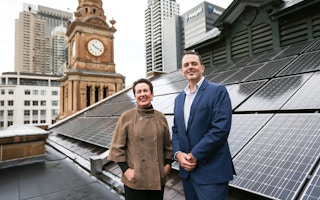The City of Sydney last Tuesday (28 March) adopted an action plan that its leaders says will help it achieve carbon neutrality and ensure that half of its energy comes from renewable energy by 2050.
To continue reading, subscribe to Eco‑Business.
There's something for everyone. We offer a range of subscription plans.
- Access our stories and receive our Insights Weekly newsletter with the free EB Member plan.
- Unlock unlimited access to our content and archive with EB Circle.
- Publish your content with EB Premium.
The Environmental Action Plan 2016-2021 (EAP) was launched for public consultation last June and adopted last Tuesday by the City of Sydney council, which governs a 25-square kilometre area of downtown Sydney including its central business district and inner city suburbs.
The EAP will see the city invest A$10 million to accelerate the uptake of renewable energy, launch a new water recycling project, and unveil a challenge for businesses to encourage Sydney’s first net-zero emissions building.
These plans, implemented over the next four years, will feed into the City’s 2030 aims, which include reducing carbon emissions by 70 per cent compared to present day levels, and running the city entirely on renewable energy and gas from renewable sources, such as biogas.
By 2031, the city expects to accommodate about 85,000 more residents compared to 2012, a 46 per cent increase; and build about 50,000 new homes.
Clover Moore, Lord Mayor of the City of Sydney, said in a statement that “the next four years are crucial”, because they will determine if the world meets the Paris climate agreement’s target of capping a global temperature rise at two degrees Celsius above pre-industrial levels.
The latest research on climate change “paints a grim picture if we don’t act now, so we’ve responded with the strongest possible plan to urgently reduce emissions,” she added.
Key emissions sources the plan aims to tackle include office and residential buildings, and the city’s power supply.
For the building sector, which produces about 80 per cent of the City area’s emissions, the council plans to continue with energy efficiency retrofits in existing, resource-intensive buildings, install more solar panels on buildings, and scale up the use of clean energy.
One example of the latter is trigeneration—a system where natural or renewable gas is burnt to produce electricity and the residual heat is used to produce hot water for heating or powering chillers, to produce low carbon electricity.
The City has a trigeneration plant at its city hall, and plans to install cogeneration systems—a similar technology—on aquatic centres in the city to further reduce emissions.
The EAP also explains how the city will achieve its ambition to cap potable water use by 2021 compared to 2006 levels: Installing smart meters in parks and buildings to detect leaks, and increasing the use of rainwater, storm water, and recycled wastewater.
To achieve the goal of becoming a “zero waste” city, where 95 per cent of construction waste and organic waste from parks is recovered by 2021, the City will undertake waste audits and include resource recovery targets in the contracts it signs with waste management service providers.
Moore shared that the City of Sydney is also asking Australia’s federal government and the New South Wales (NSW) state government to implement regulations that will help it achieve its objectives, such as doubling the Building Sustainability Index, or BASIX score, that apartment builders in NSW must achieve to be regarded as sustainable. BASIX scores are based on a building’s water and energy use.
“These new plans will help us achieve better environmental outcomes for our city and make 2017 a defining year in our long term commitment to action on climate change,” said Moore.
She added: “Now that the plan has been adopted, we can press ahead with this vital work.”








